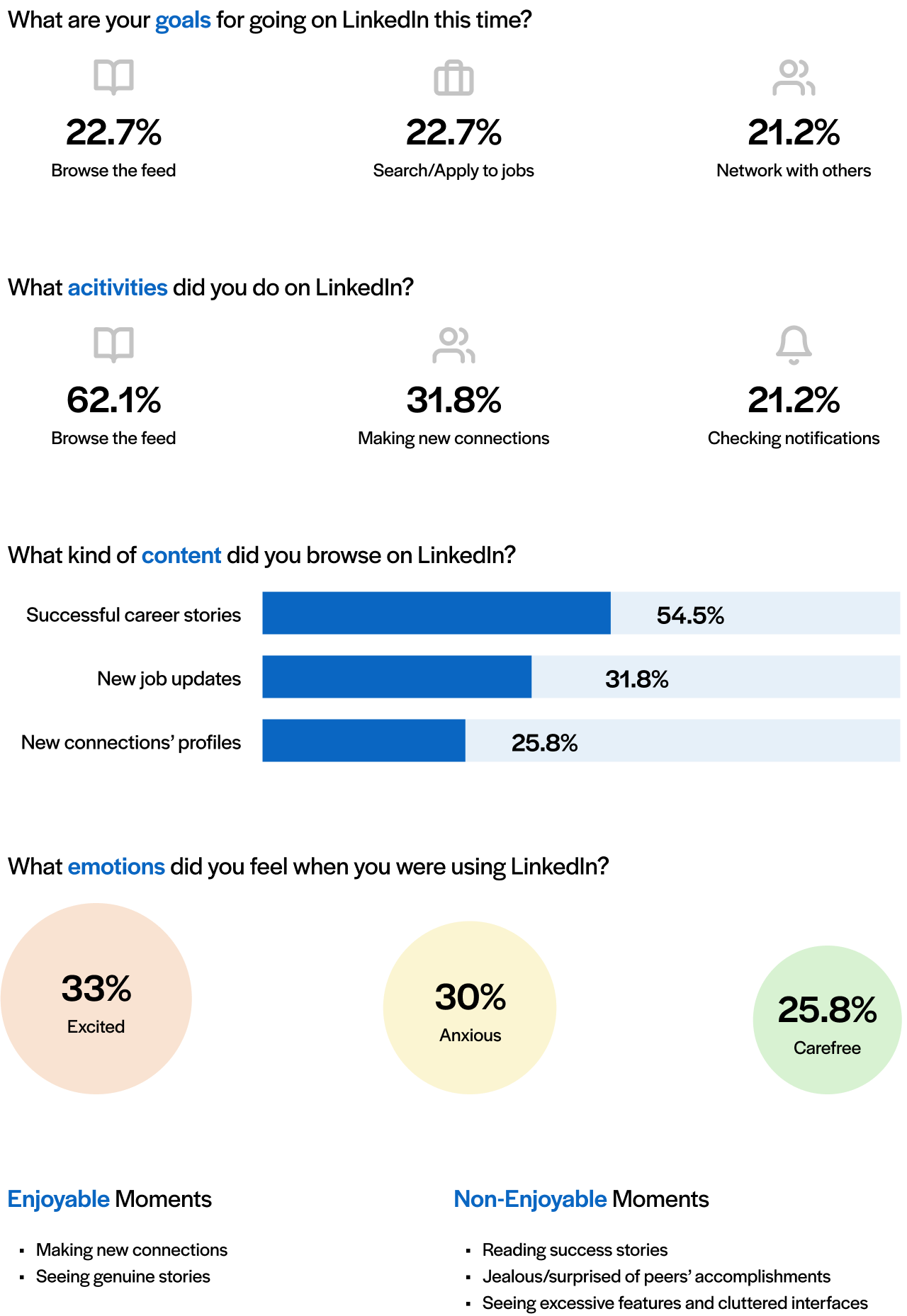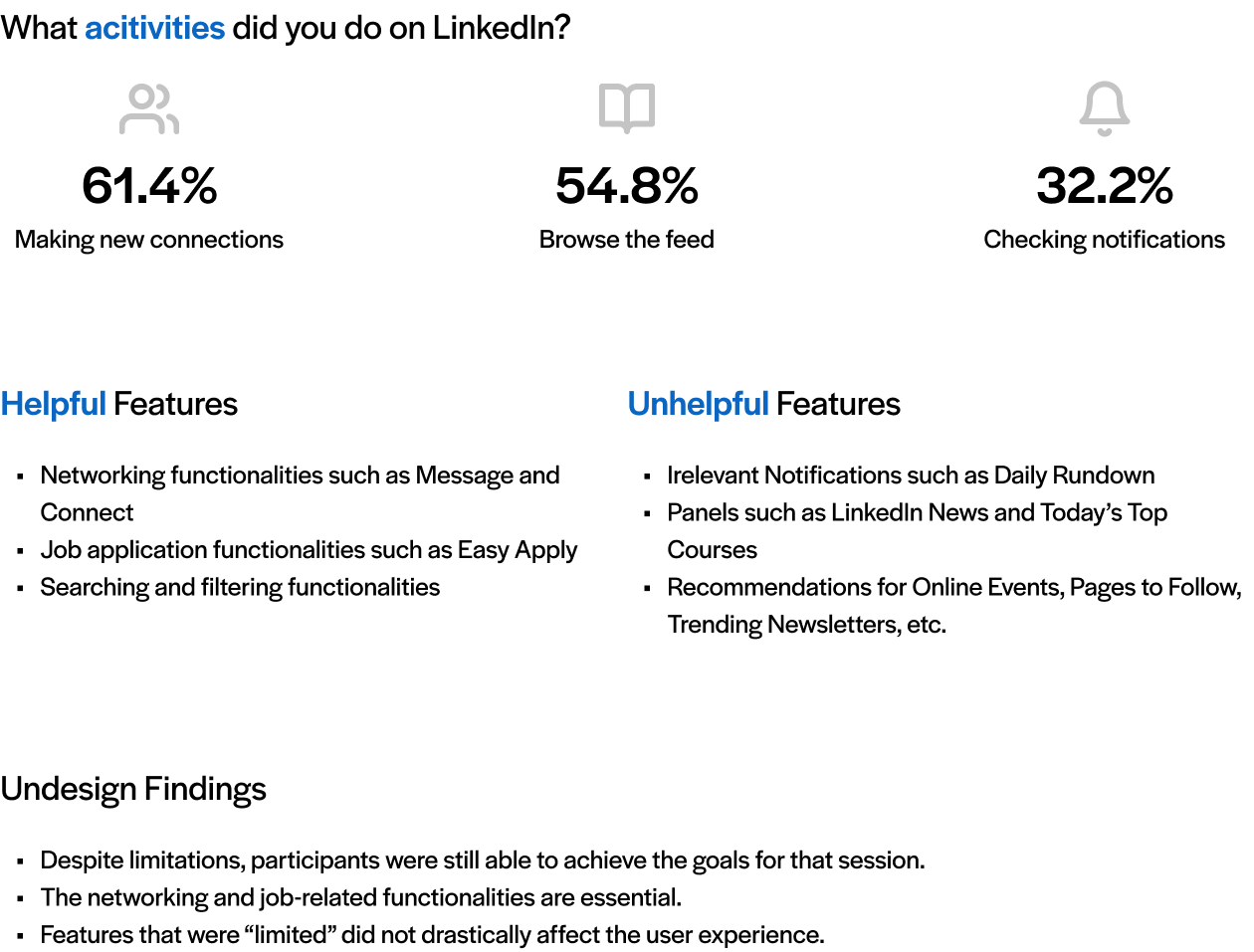Managing Emotions by Personalization and Decluttering: A LinkedIn Redesign
FALL 2020
The Challenge
How might LinkedIn be more encouraging for young adults?
The Solution
The redesign concept helps reduce the culture of sharing only highlights with no discussion of the realities of users’ professional careers by incorporating an emotion filter and enabling users to remove features on LinkedIn.
Team
Lakshita Chhikara (UX Researcher) // Daniela Saglimbeni (UX Researcher) // Priscilla Tsang (UX Researcher & Designer) // Julia Zeng (UX Researcher & Designer)
My Role
User Research, Visual Design, Prototyping
THE PROBLEMLinkedIn’s success is dampened by making young adults anxious and unwilling to engage.
Like numerous college students and young adults, I am transitioning from university to industry and eager to grow professionally. Platforms like LinkedIn have provided me opportunities to share my best work, build professional connections, and look for jobs. However, as everyone began to share their success stories, the excitement of meeting new people quickly turned into anxiety. While there is nothing wrong with presenting one's best self to others, when the platform becomes merely a highlight reel of one’s achievements, people end up constantly comparing their “regular” life to a perceived “perfect life” of others. The culture of sharing only professional highlights makes young adult users feel dejected and less willing to interact with the platform.
DESIGN CONCEPTManaging emotions by personalization and decluttering.
The redesign concept of LinkedIn aims to reduce the culture of sharing only highlights with no discussion of the realities of people’s professional careers. It contains 2 main components: an emotion filter on the Home page and a feature-removal option in Settings. The emotional filter allows users to select the type of posts they see when scrolling down their News Feed. Furthermore, the feature removal feature acts to reduce the clutter on the LinkedIn interface and allows for user personalization. Consequently, the redesign gives users the flexibility to tailor the platform to their needs, discourages social comparison, and shifts the focus from achievement display to personal growth.
01. USER RESEARCHUnderstanding why LinkedIn often triggers negative emotions.
In order to understand how users currently interact with and are influenced by LinkedIn, the team initially conducted a contextual survey with 22 LinkedIn users from Cornell University and a literature review of 9 scholarly articles. From the data gathered, we saw that feeling anxious when interacting with LinkedIn is a common emotional response regardless of users’ personality types. However, users still find LinkedIn a valuable tool when it comes to job searching and networking. These insights allowed us to form two guiding research questions:
“Are there any specific activities or content that triggers an emotional response? “
“How can we as researchers and designers eliminate, redesign, or alleviate these triggers? “
Keeping these goals in mind, we chose to conduct a Diary Study and an Autoethnography (with the thinking of un-design) to further investigate users’ goals, activities, and emotional journeys while using LinkedIn.
Diary Study: Investigating users’ emotional responses to LinkedIn activities.
We recruited 6 participants from the Cornell community and gathered 67 diary entries during a 2-week period. Each time a participant used LinkedIn, we asked them to submit a diary entry focusing on personal experiences, such as emotions, activities, and screen time. The diary study allowed us to observe participants’ mood changes during specific activities they performed on LinkedIn in their natural setting.
Key findings from Diary Study
Autoethnography: Identifying foundational and helpful features
The qualitative data gathered from the diary study inspired us to explore the concept of un-design, the intentional negation of technology, through autoethnography. We - the 4 designers and researchers - were the participants. Each of us recorded our experiences with “limited” versions of LinkedIn for 10 days. After analyzing the data, we collected insights on how specific features of LinkedIn affect usability and other parts of users’ lives. By eliminating certain features, we observed changes in the platform’s usability and if undesigned features made the platform better or worse.
Key findings from Autoethnography
Constant display of success and excessive features lead to negative users’ experiences.
We drew 4 key insights from our analysis of the Diary Study and the Autoethnography:
02. IDEATIONProfessional Growth isn’t just celebrating the results but also appreciating the process.
We ideated 22 different design concepts, including non-digital solutions. However, we chose to redesign LinkedIn instead of creating a separate/physical product because its established user groups, high switching costs, and powerful functionalities make it effective in helping users achieve their goals.
As it was clear that building a new product was unnecessary, we decided to focus on improving the current user experience of LinkedIn in 2 main areas:
Reducing the triggers for negative emotions that users may experience on LinkedIn
Highlighting aspects that are correlated with positive emotions
03. PROTOTYPINGMaking it real.
Emotion Filter
Based on the content of a post, the platform algorithmically assigns tags to that post that the user can then choose the type of posts they see when scrolling down the page.
This design was pulled directly from responses mentioning feeling stressed and anxious seeing peers’ accomplishments. In addition to giving users the power to reduce the occurrence of negative triggers, we designed and placed the tags and filters in visible areas to call attention to the different types of posts others are sharing which may motivate users to share ‘failure’ or ‘encouragement’ creating a more realistic newsfeed of professional experiences.
Emotion filter lives right below the “sort by” function at the top of the newsfeed
Feature-Removal Option
The feature-removal feature can be activated both automatically and voluntarily by the platform and users, respectively. The platform itself keeps track of user usage and patterns. Users can also manipulate the full list of features in “Settings”.
This design was inspired by our findings from the diary study in which many participants wish some features could be removed because they never used them. It was further supported by our own experiences as participants during the autoethnography — undesigned features rarely hinder the completion of intended tasks. The feature-removal option encourages users to focus on the functionalities and information they need to succeed by giving them the power to design their own LinkedIn “toolkit”.
Automated feature-removal suggestion to help users customize interfaces to fit their needs
Users can further craft their own unique LinkedIn experiences in “Settings”
04. EVALUATIONUsers’ feedback.
Due to the limited timeframe and resources, we were unable to go through multiple iterations and in-depth evaluations of the prototype. However, we gauged initial feedback on our redesign concept by asking past participants from our previous research and posting on our own LinkedIn. Although the assessment was inclusive due to the informal nature of the evaluation, comments received were overwhelmingly positive. Some direct quotes from users during usability testings include:
“I think the prototype effectively filters out undesired contents that usually make me very stressed out. The tags are great ways to sort out the information feed and I can customize my feed easily with tags.”
“I can already envision myself using it. The filter button can help me filter posts related to job search, or posts about latest network updates.”
“ I’m excited to have a home feed that’s more informational and helpful for me during job hunting instead of seeing strangers’ successful career stories.”
05. LOOKING FORWARDLimitations and future considerations.
The project topic revolves around emotional and mental aspects, which are very difficult to gauge in a short period. While we were able to identify interesting trends from our research, our observations stemmed from a small sample size. This limitation should be taken into consideration upon review of our final suggestion.
If we had more time, we would conduct more rounds of formal usability testing to see if our redesign features genuinely help users to feel more encouraged instead of anxious on LinkedIn. If the emotional filter and the feature-removal options were implemented into the actual platform, we would look for metrics such as how frequently users were utilizing the features, whether they spent more time exploring the platform, and whether they gave higher satisfaction scores.






